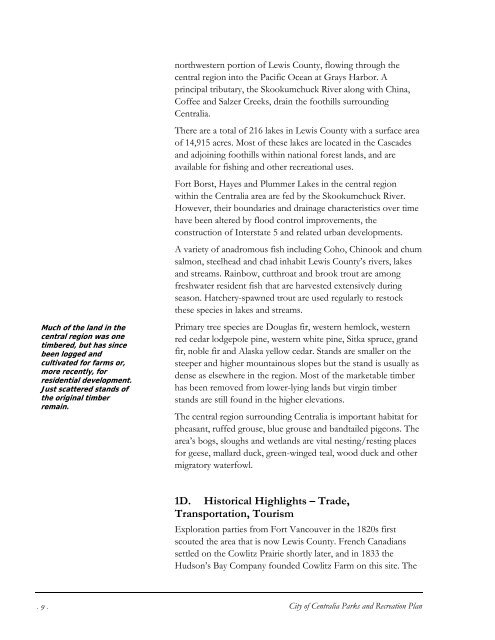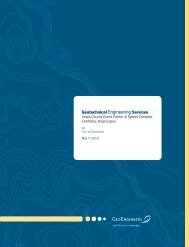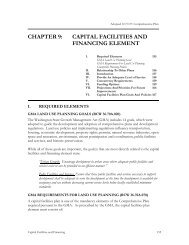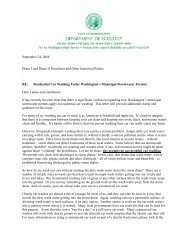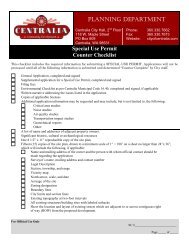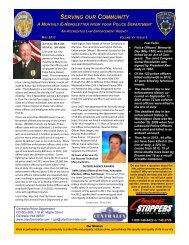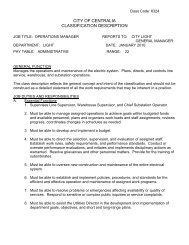Centralia Parks and Recreation Master Plan - City of Centralia, WA
Centralia Parks and Recreation Master Plan - City of Centralia, WA
Centralia Parks and Recreation Master Plan - City of Centralia, WA
Create successful ePaper yourself
Turn your PDF publications into a flip-book with our unique Google optimized e-Paper software.
northwestern portion <strong>of</strong> Lewis County, flowing through the<br />
central region into the Pacific Ocean at Grays Harbor. A<br />
principal tributary, the Skookumchuck River along with China,<br />
C<strong>of</strong>fee <strong>and</strong> Salzer Creeks, drain the foothills surrounding<br />
<strong>Centralia</strong>.<br />
There are a total <strong>of</strong> 216 lakes in Lewis County with a surface area<br />
<strong>of</strong> 14,915 acres. Most <strong>of</strong> these lakes are located in the Cascades<br />
<strong>and</strong> adjoining foothills within national forest l<strong>and</strong>s, <strong>and</strong> are<br />
available for fishing <strong>and</strong> other recreational uses.<br />
Fort Borst, Hayes <strong>and</strong> Plummer Lakes in the central region<br />
within the <strong>Centralia</strong> area are fed by the Skookumchuck River.<br />
However, their boundaries <strong>and</strong> drainage characteristics over time<br />
have been altered by flood control improvements, the<br />
construction <strong>of</strong> Interstate 5 <strong>and</strong> related urban developments.<br />
A variety <strong>of</strong> anadromous fish including Coho, Chinook <strong>and</strong> chum<br />
salmon, steelhead <strong>and</strong> chad inhabit Lewis County’s rivers, lakes<br />
<strong>and</strong> streams. Rainbow, cutthroat <strong>and</strong> brook trout are among<br />
freshwater resident fish that are harvested extensively during<br />
season. Hatchery-spawned trout are used regularly to restock<br />
these species in lakes <strong>and</strong> streams.<br />
Much <strong>of</strong> the l<strong>and</strong> in the<br />
central region was one<br />
timbered, but has since<br />
been logged <strong>and</strong><br />
cultivated for farms or,<br />
more recently, for<br />
residential development.<br />
Just scattered st<strong>and</strong>s <strong>of</strong><br />
the original timber<br />
remain.<br />
Primary tree species are Douglas fir, western hemlock, western<br />
red cedar lodgepole pine, western white pine, Sitka spruce, gr<strong>and</strong><br />
fir, noble fir <strong>and</strong> Alaska yellow cedar. St<strong>and</strong>s are smaller on the<br />
steeper <strong>and</strong> higher mountainous slopes but the st<strong>and</strong> is usually as<br />
dense as elsewhere in the region. Most <strong>of</strong> the marketable timber<br />
has been removed from lower-lying l<strong>and</strong>s but virgin timber<br />
st<strong>and</strong>s are still found in the higher elevations.<br />
The central region surrounding <strong>Centralia</strong> is important habitat for<br />
pheasant, ruffed grouse, blue grouse <strong>and</strong> b<strong>and</strong>tailed pigeons. The<br />
area’s bogs, sloughs <strong>and</strong> wetl<strong>and</strong>s are vital nesting/resting places<br />
for geese, mallard duck, green-winged teal, wood duck <strong>and</strong> other<br />
migratory waterfowl.<br />
1D. Historical Highlights – Trade,<br />
Transportation, Tourism<br />
Exploration parties from Fort Vancouver in the 1820s first<br />
scouted the area that is now Lewis County. French Canadians<br />
settled on the Cowlitz Prairie shortly later, <strong>and</strong> in 1833 the<br />
Hudson’s Bay Company founded Cowlitz Farm on this site. The<br />
- 9 -<br />
<strong>City</strong> <strong>of</strong> <strong>Centralia</strong> <strong>Parks</strong> <strong>and</strong> <strong>Recreation</strong> <strong>Plan</strong>


